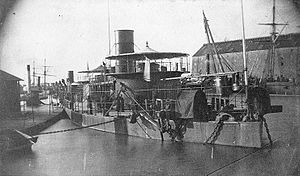- Miantonomoh class monitor
-

USS Miantonomoh in Washington Navy Yard, 1865.Class overview Builders: Portsmouth Navy Yard
New York Navy Yard
Boston Navy Yard
Philadelphia Navy YardIn commission: 4 October 1864 - 1872 Completed: 4
Miantonomoh
Monadnock
Agamenticus
TonawandaGeneral characteristics Type: Monitor Displacement: 3,400 long tons (3,455 t) Length: 258 ft 6 in (78.79 m) Beam: 52 ft 9 in (16.08 m) Draft: 12 ft 8 in (3.86 m) Propulsion: 4 Martin boilers, 2 shafts,
Agamenticus, Monadnock:
Ericsson vibrating lever engine
Miantonomoh, Tonawanda:
horizontal return connecting rod engine, 1,400 ihp (1,044 kW)Speed: 9–10 knots (17–19 km/h; 10–12 mph) Complement: 150 Armament: 4 × 15 in (380 mm) smoothbore Dahlgren guns (2×2) Armor: Iron
Side: 5 in (130 mm)
Turrets: 10 in (250 mm)
Deck: 1.5 in (38 mm)The Miantonomoh class monitors of the U.S. Navy were constructed during the U.S. Civil War, but only one ship of the class actually took part in it. They were broken up in 1874/5.
The ships of this class were designed by the Bureau of Construction and Repair, and were wooden-hulled. The Monadnock, the only one to take part in the Civil War, is usually considered the best of the U.S. monitors. In 1865/6 she went to San Francisco, via the Strait of Magellan and although three ships were in company, she was not towed.
Miantonomoh crossed the Atlantic in 1866, though she was towed for 1,100 miles by the side-wheel steamer Augusta. She returned in 1867 after a cruise of 17,767 miles. Two other ships, the Agamenticus and the Tonawanda were renamed Terror and Amphitrite respectively, on 15 June 1869.
The hull was of normal form without the Ericsson overhang, and freeboard is given as 2 feet 7 inches. The armour was made up of 1 inch plates and there were pilothouses on both turrets, with armored bases to the funnel and a large ventilation shaft abaft it. The turrets were 23 feet internal diameter and thus 2 feet larger than in the Passaic class, and a light hurricane deck was rigged between them.
Unfortunately the wooden hulls decayed and the supposed rebuilding of this class of vessels into the iron-hulled "New Navy" monitors of the same names, was a fiction to explain Congressional refusal to allocate any funds for new construction.
See also
for the new constructed monitors of the "New Navy".
References
- Gardiner, Robert (1979). Conway's All The World's Fighting Ships 1860-1905. Conway Maritime Press. pp. p. 121. ISBN 0 85177 133 5.
Miantonomoh-class monitorList of monitors of the United States Navy Ironclads of the U.S. NavyMonitors Coastal monitorsRiver and harbor monitorsRiverine casemate ironcladsOcean-going casemate ironcladsWar Prizes Commissioned ironcladsNon-commissioned ironcladsMiscellaneous ironclads Categories:- Monitor classes
- Miantonomoh class monitors
Wikimedia Foundation. 2010.
Look at other dictionaries:
Marietta class monitor — Class overview Name: Marietta class monitor Builders: Tomlinson and Hartupee Co., Pittsburgh, PA Operators … Wikipedia
Neosho class monitor — A drawing of Neosho as she appeared in 1863 Class overview Name: Neosho class monitor Builders: Union Iron Works, C … Wikipedia
Cerberus class monitor — Stern view of Cerberus at Williamstown, Victoria in 1871 Class overview Builders: Thames Ironworks and Shipbuilding Company … Wikipedia
City class ironclad — USS Cairo on the Mississippi River in 1862. Class overview Name: City class gunboat Builders: James B … Wikipedia
Portsmouth Naval Shipyard — (14 gun Schooner) * 1799 (50 gun Frigate) * 1842 USS|Saratoga|1842|2 (24 gun Sloop of war) * 1843 USS|Portsmouth|1843|2 (24 gun Sloop of war) * 1848 USS|Saranac|1848|2 (steam sloop) * 1855 USS|Santee|1855|2 (44 gun Frigate) * 1855 LV 1 Lightship… … Wikipedia
USS Agamenticus (1863) — USS Agamenticus was a Miantonomoh class monitor of the United States Navy, named after Mount Agamenticus in York County, Maine.The twin screw, double turreted ironclad monitor was laid down sometime in 1862 at Portsmouth Navy Yard in Kittery,… … Wikipedia
List of monitors of the United States Navy — This is a list of all monitors of the United States Navy. While the most famous name is represented in this list, many monitors held multiple names during their service life. To view the complete list of names, click .The whole category of… … Wikipedia
USS Tonawanda (1864) — The USS Tonawanda a double turreted coastal monitor built by the Philadelphia Navy Yard was launched on 6 May 1864; and commissioned on 12 October 1865, Commander William Ronckendorff in command.The Tonawanda was designed by Chief of Naval… … Wikipedia
USS Monadnock (1864) — The first USS Monadnock , a twin‑screw, wooden‑hull, double turreted, ironclad monitor was laid down at the Boston Navy Yard, Charlestown, MA, in 1862; launched 23 March 1863; and commissioned at the Boston Navy Yard 4 October 1864, Captain John… … Wikipedia
USS Monadnock (BM-3) — For other ships of the same name, see USS Monadnock. Monadnock crossing the Pacific Ocean during the Spanish American War Career … Wikipedia
